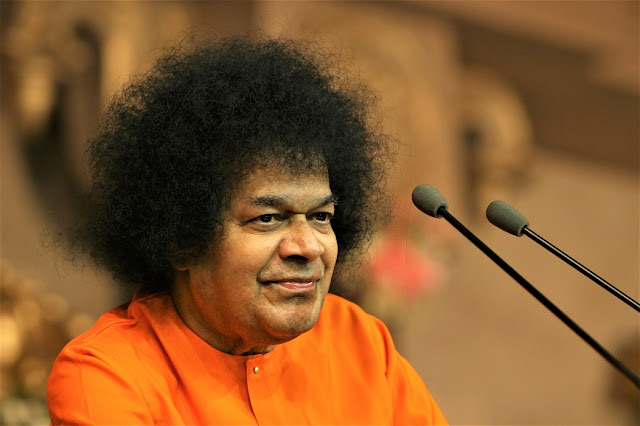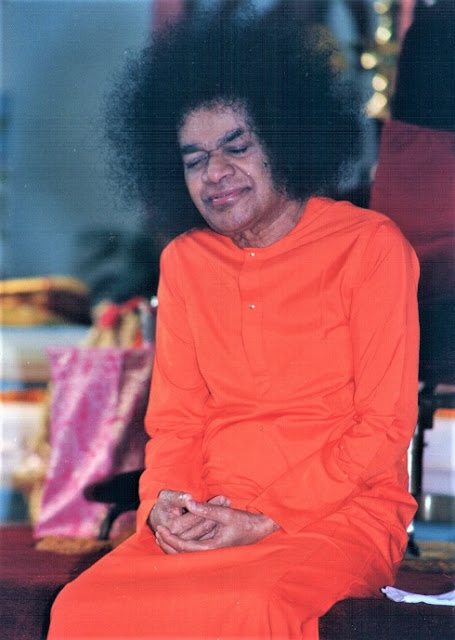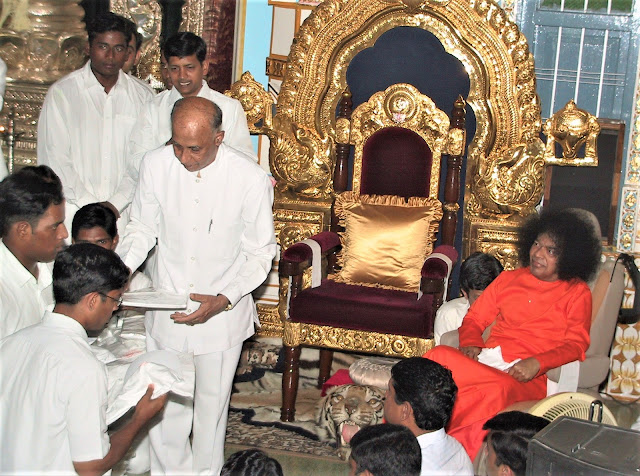Tuesday, August 15, 1995 to Wednesday, August 23, 1995
From 15th August 1995 onwards, many special programmes were organised by different groups of devotees as their special offering to Bhagavan for His 70th Birthday due in November. The first of these events was a superb dramatic presentation by a group of Bal Vikas students from Germany. On August 16th and 17th, two Telugu films ‘Bhakta Ramdas’ and ‘Satya Harishchandra,’ were screened in the Divine Presence.
On Krishnashtami morning, 18th August 1995, Bhagavan gave Darshan clad in a yellow robe. All the cows of Gokulam proceeded to Sai Kulwant Hall led by the majestic Sai Geeta. Swami fed them with fruits. Bhagavan, in the course of His Discourse at Sai Kulwant Hall in the afternoon explained the nature of devotion to God and how the Gopikas were perfect examples of total devotion.
On 20th August, a mass marriage ceremony of 120 couples was arranged in the Divine Presence by the alumni of Anantapur campus. Bhagavan deeply appreciated the initiative of the ‘Messengers’ and He personally arranged for the other necessities required for the celebration. On 19th, He distributed the wedding clothes to the brides and the grooms. At 7 am on 20th morning, the priest conducted the marriage ceremony at Sai Kulwant Hall. After the ceremony Bhagavan went around the long rows of the couples and sprinkled Akshata (rice grains) on them.
On 21st August 1995, the wives of the staff of the Sri Sathya Sai Institute, and the Lady teachers of the Secondary School, arranged for a Shashtiabhdapoorti (completion of 60 years of age considered auspicious in Indian culture) function of 70 poor and aged couples from Puttaparthi and the neighbouring villages. On 21st morning, Bhagavan blessed the couples individually after the function was over.
On 22nd August, a traditional Kanya Puja was performed for 150 young, unmarried girls in Sai Kulwant Hall. After the Puja, Bhagavan blessed the girls individually.
On the 23rd August, a ‘Divya Upanayana Mahotsavam’ for 560 boys was arranged in Sai Kulwant Hall by the Mahila Vibhag of Hyderabad Sathya Sai Samiti. After the main ritual of Gayatri Mantra initiation and the thread ceremony, Bhagavan went around the entire hall showering consecrated rice on them and blessing the vatus and their parents. The functions lasted nearly 3 hours and Bhagavan was on His feet throughout. In the Discourse, He said:
“Man today spends his life fully preoccupied with worldly concerns. Owing to attachment to the body; he forgets his true nature, is immersed in the affairs of the body as permanent and. makes bodily comforts his goal in life. These are the things which every individual experiences in daily life. If anybody accosts a person and asks him, "Who are you?", out of his identification with the body he gives his name in reply. In answer to further questions he introduces himself as a doctor, a farmer, or student, or the like. When the enquiry goes further, he identifies himself with his nationality as an American, an Indian, a Pakistani or so on. When you examine these answers deeply, you will find that none of them gives the truth.
He got his name from his parents. It did not belong to him at birth. His identification with one or other of his professions is not true because he is not the profession. What, then, is the truth about him? "I am the Atma. That is my true Self." That is the truth. But people identify themselves with their names, professions and nationality and do not base their lives on the Atma. No driver of a car identifies with the car. Likewise the body is a car and the Atma is the driver. Forgetting one's true role as a driver, one is identifying one's self with the body, which is only a vehicle.
This truth is emphatically brought out by the Gayatri Mantra. "Deha Budhyaat Daasoham" (From the standpoint of the body, I am your instrument, your servant). "Jeeva Budhyaat Tvadamshah" (In the context of the Jeeva, the individual soul, I am a spark of the Divine Thou). "Atma Budhyaat Tvameva-Aham" (In terms of the Atma I am yourself). When one views one's self from the Atmic standpoint, one is identical with the Divine. "I am you and you are me."
Our life is a three-storeyed mansion
Every man has thus three aspects. Our life itself is a three-storeyed mansion. The Brahmacharya (celibate) stage is the foundation of this mansion. After that, the stage of Grihastha (householder) is the first floor. Then you have the Vaanaprastha (retirement from the life of a householder) stage as the second floor. Finally, there is the stage of the Sanyasa (renunciant), consisting-the third floor. Thus, Brahmacharya is the foundation for the other three stages of life. The safety and security of the other three floors depend on the strength of the foundation, vis, Brahmacharya. Hence, Brahmacharya is the basic foundation.
But, unfortunately this vital fact has been forgotten by people. They feel happy on seeing the super-structure. But the whole edifice may collapse at any time if the foundation is weak. When you feel happy at the sight of a tree and its flowers and fruits, you must be concerned about its roots. The unseen foundation is the basis for the visible mansion. The invisible roots are the basis for the visible tree. Likewise, the invisible Praana (Life-Breath or Force) is the basis for the visible body. Praana has no form, while the body has a form. There is, however, the Atmic principle which confers all the potencies for the Praana (Life Force). It is because of the power imparted by the Atma that the Life Force is able to activate the body. The body inherently is inert. It is made up of different kinds of material substances.
Three potencies in every Human
In the Gayatri Mantra the first line is: ‘Om Bhur Bhuva Suvah’. This Mantra is assumed to refer to three worlds, the earth, the middle world and Heaven - Swarga, the land of the gods. Bhu refers to the body. It is made up of Pancha Bhutas (five great, elements). These five elements constitute Prakriti (Nature). There is an intimate relationship between the body and Nature. The same five elements that are in the nature are also in the body. Bhuvah is the Praana Shakti (Life Force) that animates the body. Even if the Life Force exists, without Jnana (Awareness) the body will be of no use. It is on this account that the Vedas declared: "Prajnaanam Brahma" (Constant Integrated Awareness is Brahman). It is by the presence of Prajnaana that the Life Force is able to animate the body. The body represents inert matter. The Life Force operates in the body as a vibration. This Vibration derives its power from Prajnaana, which finds expression in radiation.
Therefore, the body, the Life Force and the Prajnana are all within man. The entire cosmos is present in miniature within man. It is because of these three constituents that we are able to see the cosmos and experience many other things. Every potency is within us. The external is a reflection of the inner being.
It follows from this that true Manavatvam (humanness) is Daivatvam (Divinity) itself. Hence, the Vedas declared that the divine appears in human form. Every human being is inherently Divine, but owing to his attachment to the body he' considers himself a mere man. How did this human body get animated by the Life Force? Whence has this Life Force come? It is from the Atma-Shakti (the power of the Self). Making use of this power of the Sell the Life Force carries out all activities.
Triple Aspects of Gayatri
Who is Gayatri? Gayatri is not a goddess. "Gayatri Chandasaam Mata" (Gayatri is the mother of the Vedhas) "Gaayantam Traayate Iti Gayatri" (Gayatri is that which redeems the chanter of the Mantra). Gayatri is present wherever the Mantra is chanted. Gayatri, however, has three names' Gayatri, Savitri, Saraswati. These three are present in everyone. Gayatri represents the senses. It is the master of the senses. Savitri is the master of Praana (Life Force). Many Bharatiyas are familiar with the story of Savitri who brought back to life her dead husband, Satyavaan. Savitri signifies truth. Saraswati is the presiding deity of Vaak (Speech). The three represent Trikarana Shuddhi (purity in thought, word and deed). Although Gayatri has three names, all the three are in each of us as the senses (Gayatri), the power of speech (Saraswati) and the Life Force (Savitri).
Gayatri is said to have five faces and hence is called Pancha Mukhi. Is there anybody in the world with five faces? No. In the Ramayana, Ravana is said to have ten heads. If really he had ten heads, how would he be able to lie in his bed or move about? This is not the inner meaning of this description. He is said to be ten-headed because he was the master of the four Vedas and the six Shastras. Likewise, Gayatri is described as five-faced. The five faces are as follows. Om (the Pranava) is the first face. The Pranava Principle represents the Ashta-Aishvarya (eight different forms of wealth). The second face is: "Bhur Bhuva Suvah." The third is: "Tat-Savitur-Varenyam." The fourth is "Bhargo Devasya Dheemahi". The fifth face is: "Dhiyo Yonah Prachodayaat." When the Gayatri Mantra is understood in this way, it will be realised that all the five aspects of Gayatri are within each of us.
Power of Gayatri Mantra
The Gayatri Mantra has all the three elements which figure in the adoration of God description, meditation and prayer. The first nine words of the Mantra - "Om-Bhur-BhuvasSuvah-Tat-Savitur-Varenyam-Bhargo-Devasya" – represent the attributes of the Divine. Dheemahi pertains to Dhyana (meditation). "Dhiyo Yonah Prachodayaat" is the prayer to the Lord. The Mantra is thus a prayer to God to confer all powers and talents. "Sarva Roga Nivaarini Gayatri" (Gayatri is the reliever of all diseases). "Sarva Dukha Parihaarini Gayatri" (Gayatri wards off all misery). "Sarva Vaancha Phala Siddhi Gayatri" (Gayatri is the fulfiller of all desires). Gayatri is the bestower of all that is beneficial. If the Mantra is chanted, various kinds of powers will emerge in one.
Hence the Gayatri Mantra should not be treated casually. In our respiration process the sound of Gayatri is embedded. That sound is a reminder of our true form. In the breathing process, there is inhalation and exhalation. In the Yoga-Shastra, inhalation is termed Poorakam and the exhalation is called Rechakam. Holding the breath is called Kumbhakam. When air is inhaled, the sound that is produced' is 'So-o-o.' When it is exhaled, the sound is 'Ham-m-m.' 'So-ham, Soham.' (Bhagavan demonstrated how this happens while breathing in and out). 'So' is "that." 'Ham' is "I". "I am That," "I am Divine." Every breath proclaims this. The Vedas declared the same thing in the pronouncements: "Tat Tvam Asi" (That thou art), "Aham Brahmaasmi" (I am Brahman), "Ayam Atma Brahma" (This Self is Brahman).
Gayatri is the Indweller
Don't imagine God is somewhere remote from you. He is within you. You are God. People want to see God. "Satyam Jnanam Anantam Brahma", say the scriptures. Truth. is God. Wisdom is God. Both these are present everywhere. They transcend the categories of time and place. Truth is that which is valid at all times – past, present and future. That truth is Gayatri.
Gayatri is thus the indweller in the Hridaya (heart). Hridaya contains the word Daya meaning compassion. There is compassion in every heart. But to what extent is it shown in real life? Very little. All the while only anger, jealousy, pride and hatred are displayed. These evil qualities are not natural to man. They are opposed to human nature.
It has been declared that one who bases himself entirely on the mind is a demon. One who bases himself on the body is an animal. One who follows the Atma (the Self) is divinely endowed. One who relies on the body, the mind and the Atma is a human being. Humanness is the combination of the body; mind and Atma. Man should strive to ascend to the divine and not descend to the demonic or animal nature.
How to remove insecurity and secure security?
From today onwards parents should teach their children stories with morals. You all know in what a chaotic condition the world is today. Disorder and violence are rampant everywhere. Peace and security are not to be found anywhere. Where is peace to be found? It is within us. Security is also within us. How is insecurity to be removed and security secured? It is by giving up desires. In the language of the ancient Bhaaratheeyas this was termed Vairaagya (giving up attachment). This does not mean giving up home and family and retiring into the forest. It is reduction of wants. As a householder limit your desires to the needs of the family. As a student, stick to your studies. As a professional, adhere to the duties of your profession. Do not indulge in excesses of any kind.
In the practice of the Gayatri Mantra, one should realise that everything is within one and thereby develop confidence in the Self. Man today is racked by numerous troubles because he has no confidence in the Sell The aspirant on the spiritual path is bound to face the troubles caused by the six enemies, lust, anger, greed, infatuation, pride and envy. He has to overcome them.
Students! On an auspicious occasion like this, you should consider how you can lead an ideal life. Through faith in God, you have to sanctify the body. Without the body, you cannot experience the mind and the intellect. To achieve your ideals, the body is the instrument. It should be kept in proper condition. While the body is an instrument, the user of the instrument is the Self. All senses function because of the Aathma. The Aathma is the Witness to everything. It is also known as Conscious Self. It derives its sanction from the Divine. It is a fragment of the Divine. Every human being is a spark of the Divine, as declared in the Geetha. The human being is essentially Divine, but tends to forget his Divine origin.
The Gayatri Mantra is enough to protect the person who chants it, because Gayatri embodies all the Divine potencies. It is an essential requisite for the young because it ensures a bright and auspicious future for them. The young students are the citizens and leaders of tomorrow. Hence, they should develop pure and noble thoughts. The parents also should foster such a development.
The Meaning of Upanayanam
The Upanayanam ceremony is just over. The Gayatri Mantra has been imparted to you. You are wearing the sacred thread with three strands tied in one knot. The three strands represent Brahma, Vishnu and Maheshvara. They also represent the .past, the present and future. Upanayanam means being near to God. Nearness to God will enable you to get rid of your bad qualities and acquire virtues.
The Vedas have emphasized three duties. Esteem the mother as God, the father as God and the preceptor as God. Bear this injunction in mind. Gratitude to your parents is your foremost duty. This is the lesson taught by Shri Rama. Love your parents and remember God. When you please your parents and make them happy, your entire life will be filled with happiness. Chant the Gayatri as often as possible. If you chant it while you take a bath, your bath gets sanctified. Likewise chant it before taking your food. The food becomes an offering to the Divine. Develop heartfelt devotion to God.






















